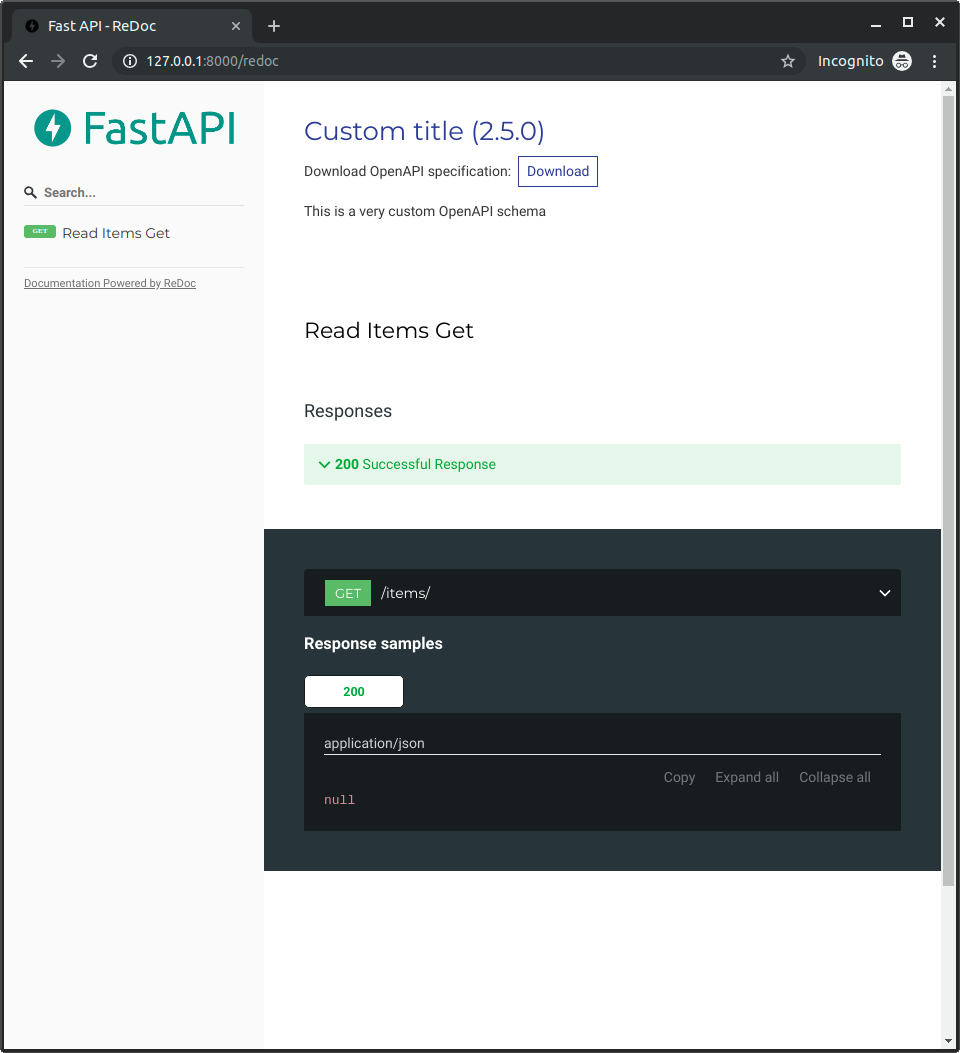扩展 OpenAPI¶
在某些情况下,你可能需要修改生成的 OpenAPI 模式。
本节将介绍如何操作。
正常流程¶
正常(默认)流程如下:
一个 FastAPI 应用程序(实例)有一个 .openapi() 方法,该方法应返回 OpenAPI 模式。
作为应用程序对象创建的一部分,会注册一个用于 /openapi.json(或你设置的任何 openapi_url)的 *路径操作*。
它只返回一个 JSON 响应,其中包含应用程序 .openapi() 方法的结果。
默认情况下,.openapi() 方法会检查 .openapi_schema 属性以查看其是否有内容并返回它们。
如果没有,它会使用 fastapi.openapi.utils.get_openapi 中的实用函数来生成它们。
而且,该 get_openapi() 函数接收以下参数:
title:OpenAPI 标题,在文档中显示。version:你的 API 版本,例如2.5.0。openapi_version:使用的 OpenAPI 规范版本。默认情况下,为最新版本:3.1.0。summary:API 的简短摘要。description:你的 API 描述,可以包含 Markdown,并将在文档中显示。routes:路由列表,这些是每个已注册的 *路径操作*。它们取自app.routes。
信息
参数 summary 在 OpenAPI 3.1.0 及更高版本中可用,并由 FastAPI 0.99.0 及更高版本支持。
覆盖默认设置¶
使用上述信息,你可以使用相同的实用函数来生成 OpenAPI 模式并覆盖你需要修改的每个部分。
例如,让我们添加 ReDoc 的 OpenAPI 扩展以包含自定义徽标。
正常的 FastAPI¶
首先,像往常一样编写你的 FastAPI 应用程序
from fastapi import FastAPI
from fastapi.openapi.utils import get_openapi
app = FastAPI()
@app.get("/items/")
async def read_items():
return [{"name": "Foo"}]
def custom_openapi():
if app.openapi_schema:
return app.openapi_schema
openapi_schema = get_openapi(
title="Custom title",
version="2.5.0",
summary="This is a very custom OpenAPI schema",
description="Here's a longer description of the custom **OpenAPI** schema",
routes=app.routes,
)
openapi_schema["info"]["x-logo"] = {
"url": "https://fastapi.org.cn/img/logo-margin/logo-teal.png"
}
app.openapi_schema = openapi_schema
return app.openapi_schema
app.openapi = custom_openapi
生成 OpenAPI 模式¶
然后,在 custom_openapi() 函数内部使用相同的实用函数生成 OpenAPI 模式
from fastapi import FastAPI
from fastapi.openapi.utils import get_openapi
app = FastAPI()
@app.get("/items/")
async def read_items():
return [{"name": "Foo"}]
def custom_openapi():
if app.openapi_schema:
return app.openapi_schema
openapi_schema = get_openapi(
title="Custom title",
version="2.5.0",
summary="This is a very custom OpenAPI schema",
description="Here's a longer description of the custom **OpenAPI** schema",
routes=app.routes,
)
openapi_schema["info"]["x-logo"] = {
"url": "https://fastapi.org.cn/img/logo-margin/logo-teal.png"
}
app.openapi_schema = openapi_schema
return app.openapi_schema
app.openapi = custom_openapi
修改 OpenAPI 模式¶
现在你可以添加 ReDoc 扩展,在 OpenAPI 模式的 info “对象”中添加一个自定义的 x-logo
from fastapi import FastAPI
from fastapi.openapi.utils import get_openapi
app = FastAPI()
@app.get("/items/")
async def read_items():
return [{"name": "Foo"}]
def custom_openapi():
if app.openapi_schema:
return app.openapi_schema
openapi_schema = get_openapi(
title="Custom title",
version="2.5.0",
summary="This is a very custom OpenAPI schema",
description="Here's a longer description of the custom **OpenAPI** schema",
routes=app.routes,
)
openapi_schema["info"]["x-logo"] = {
"url": "https://fastapi.org.cn/img/logo-margin/logo-teal.png"
}
app.openapi_schema = openapi_schema
return app.openapi_schema
app.openapi = custom_openapi
缓存 OpenAPI 模式¶
你可以使用属性 .openapi_schema 作为“缓存”,来存储你生成的模式。
这样,你的应用程序就不必在每次用户打开 API 文档时都生成模式。
它只会生成一次,然后相同的缓存模式将用于后续请求。
from fastapi import FastAPI
from fastapi.openapi.utils import get_openapi
app = FastAPI()
@app.get("/items/")
async def read_items():
return [{"name": "Foo"}]
def custom_openapi():
if app.openapi_schema:
return app.openapi_schema
openapi_schema = get_openapi(
title="Custom title",
version="2.5.0",
summary="This is a very custom OpenAPI schema",
description="Here's a longer description of the custom **OpenAPI** schema",
routes=app.routes,
)
openapi_schema["info"]["x-logo"] = {
"url": "https://fastapi.org.cn/img/logo-margin/logo-teal.png"
}
app.openapi_schema = openapi_schema
return app.openapi_schema
app.openapi = custom_openapi
覆盖方法¶
现在你可以用你的新函数替换 .openapi() 方法。
from fastapi import FastAPI
from fastapi.openapi.utils import get_openapi
app = FastAPI()
@app.get("/items/")
async def read_items():
return [{"name": "Foo"}]
def custom_openapi():
if app.openapi_schema:
return app.openapi_schema
openapi_schema = get_openapi(
title="Custom title",
version="2.5.0",
summary="This is a very custom OpenAPI schema",
description="Here's a longer description of the custom **OpenAPI** schema",
routes=app.routes,
)
openapi_schema["info"]["x-logo"] = {
"url": "https://fastapi.org.cn/img/logo-margin/logo-teal.png"
}
app.openapi_schema = openapi_schema
return app.openapi_schema
app.openapi = custom_openapi
检查它¶
一旦你访问 http://127.0.0.1:8000/redoc,你将看到你正在使用自定义徽标(在此示例中是 FastAPI 的徽标)
